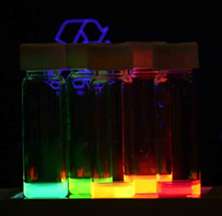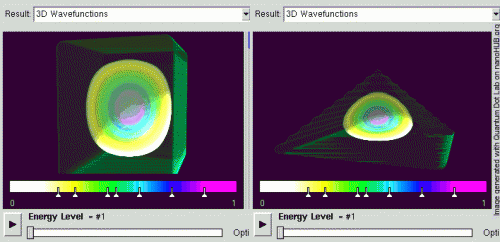August 2, 2011 feature
Tiny tech, big results: Quantum dot solar cells increase solar conversion efficiency

The race to achieve ever-higher photovoltaic conversion ratios is, so to speak, a hot area of research. One line of research has focused on quantum dots – semiconductor nanocrystals under 2-10 nanometers (about 10-50 atoms) in diameter in which electron motion is confined in all three dimensions – as the fundamental elements of nanoscale solar cell technology.
Sometimes called artificial atoms, nanoparticles composed of cadmium, zinc, tellurium, selenium, sulfur and other compounds are so miniscule that adding or removing a single electron represents a significant change – a property that makes them suitable not only as components of advanced solar cells, but also in solid state lighting, medical sensors and other applications.
In particular, colloidal quantum dots (CQDs) – synthesized from a three-component system composed of: precursors, organic surfactants, and solvents – can be tuned by changing their size, which in photovoltaic structures allows their spectral response to be tailored as needed. Recently, researchers in the Department of Electrical and Computer Engineering at the University of Toronto have demonstrated the first CQD tandem solar cells (a series of connected solar cell in which adding more devices allows for each device to be optimized to a narrower spectrum giving a higher overall efficiency) using the size-effect tuning of a single CQD material, lead(II) sulfide (PbS). Their ability to tune CQD films may allow tandem and multi-junction solar cells (fabricated by combining CQDs of differing sizes) to raise solar cell conversion limits from its current 31% to 42% 49%, respectively.
The research – led by Prof. Edward H. Sargent, along with Xihua Wang, Ghada I. Koleilat, and other University of Toronto researchers – overcame the difficulties encountered by previous CQD photovoltaic research, which were stonewalled by a key missing piece: the junction – the point of connection – between the front and back cells. “Prior to our paper,” says Sargent, “there had been no prior reports of a colloidal quantum dot solar cell that efficiently matches the currents in the front, or visible-wavelength-bandgap, cell, and the back infrared-bandgap cell, and that successfully sums the voltages in each cell. We developed a new technique – which we term the Graded Recombination Layer – that connects the front and back cells with essentially no performance loss through a series of materials that gradually transfer front cell activity to that of the back cell.”
The key is that this stack of materials is highly transparent, and therefore proved highly effective in building the first efficient colloidal quantum dot tandem cell. At this point, adds Sargent, “The main advanced need in CQD photovoltaics is improved transport within the colloidal quantum dot layer itself. This will benefit single-junction and multi-junction solar cells alike.”
In terms of applications, Sargent notes that “Once we exceed 10% solar power conversion efficiency (today the best reports for CQD photovoltaics are 5.6%, so we still have a way to go), we will be poised to create flexible, large-area solar cells at low cost. Specifically, out target efficiency combined with our low materials and manufacturing costs will lead to a dramatic improvement in overall installed cost per Watt*peak.”

It follows, then, that CQD photovoltaics are amenable to significant scaling. “Even in the R&D lab,” Sargent points out, “we synthesize enough colloidal quantum dots in each run to cover a square meter of surface with a complete light absorber. Work remains to be done in developing the final thin-film-processing approaches that are compatible with large-area roll-to-roll processing.”
Sargent notes that there is some overlap with Stanford University’s Photon Enhanced Thermionic Emission (PETE) research. PETE increases the energy conversion efficiency of thermionic devices (which convert heat to electricity) implemented as topping cycles for solar thermal systems, thereby potentially doubling photovoltaic conversion ratios. “What our approaches have in common is splitting the spectrum into two components – the higher-energy visible and the lower-energy but abundant-photon-fluence, or flux, infrared. That said,” he stresses, “there are also important differences: our approach does not require optical concentration, while PETE does. Also, ours works best at typical ambient temperatures; PETE requires that the cathode operate at 600-800ºC.”
Sargent sees the next steps in the team’s research as being “focused on the task of enhancing electron and hole transport inside colloidal quantum dot films with the goal of making low-temperature-processed, flexible, low-cost solar cells that exceed 10% solar power conversion efficiency.”
More information: Tandem colloidal quantum dot solar cells employing a graded recombination layer, Nature Photonics 5, 480–484 (2011), Published online 26 June 2011, doi:10.1038/nphoton.2011.123
Copyright 2011 PhysOrg.com.
All rights reserved. This material may not be published, broadcast, rewritten or redistributed in whole or part without the express written permission of PhysOrg.com.



















